
|
It brightened up to -4.9 mag due to the forward scattering on Oct. 9 in the SOHO coronagraph images (M. Paradowski). It became a great comet of 0 mag on the ground. Now it is 6.0 mag (Oct. 30, Chris Wyatt). Fading rapidly. It will be unobservable soon in the Southern Hemisphere, or in January in the Northern Hemisphere. But it will be observable again in January in the Northern Hemisphere.
Date(TT) R.A. (2000) Decl. Delta r Elong. m1 Best Time(A, h)
Nov. 2 18 3.86 3 45.7 1.013 0.945 56 5.8 20:04 (104, 13)
Nov. 9 18 27.24 3 55.9 1.255 1.078 55 6.7 20:13 (102, 10)
|

|
Bright new Kreutz sungrazer comet. Although the brightness evolution almost stopped until mid October, a large outburst occured on Oct. 18 and it brightened up to 8.2 mag (Oct. 20, Martin Masek). It approached to Sun down to 0.008 a.u. on Oct. 28. It was expected to brighten up to 2 mag, or -4.5 mag at best. However, it completely disappered at the perihelion. It will be observable soon, but probably nothing remains.
Date(TT) R.A. (2000) Decl. Delta r Elong. m1 Best Time(A, h)
Nov. 2 13 20.11 -16 57.8 1.009 0.292 16 7.7 3:23 (294, -5)
Nov. 9 12 41.58 -22 19.6 0.995 0.553 32 9.9 3:14 (291, 10)
|

|
It returned for the first time in 68 years. It brightened up to 6.2 mag in early summer (July 1, Virgilio Gonano). Now it is 9.9 mag (Oct. 27, Mike Olason). It will fade out rapidly after this. In the Northern Hemisphere, it will be unobservable soon. But it will be observable again in January. In the Southern Hemisphere, it is not observable now, but it will appear in January.
Date(TT) R.A. (2000) Decl. Delta r Elong. m1 Best Time(A, h)
Nov. 2 15 47.43 -5 24.5 3.021 2.128 21 11.3 20:04 ( 76,-10)
Nov. 9 16 0.66 -7 7.0 3.120 2.202 18 11.6 20:13 ( 71,-13)
|

|
It is expected to brighten very rapidly up to 10 mag from November to Decemebr. Now it is 14.5 mag (Oct. 31, Katsumi Yoshimoto). It brightens up to 9.5 mag, but it will turn to fade out rapidly after that. In the Northern Hemisphere, it stays observable in good condition. In the Southern Hemisphere, it will be unobservable in December.
Date(TT) R.A. (2000) Decl. Delta r Elong. m1 Best Time(A, h)
Nov. 2 10 53.59 4 56.2 1.373 1.176 56 12.8 3:23 (255, 12)
Nov. 9 11 3.64 9 11.1 1.177 1.148 63 11.7 3:14 (250, 12)
|
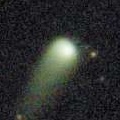
|
Now it is 13.1 mag (Oct. 27, Thomas Lehmann). It stays 12 mag for a while. In the Northern Hemisphere, it stays observable in good condition. In the Southern Hemisphere, it is not observable now.
Date(TT) R.A. (2000) Decl. Delta r Elong. m1 Best Time(A, h)
Nov. 2 6 56.47 61 11.1 3.176 3.692 113 11.8 3:23 (186, -7)
Nov. 9 6 35.89 63 33.4 3.100 3.700 120 11.8 3:14 (181, -8)
|

|
It returns for the first time in 70 years. It brightened up to 3.7 mag in early April (Apr. 6, Jose Guilherme Aguiar). Now it is 14.6 mag (Oct. 22, Hidetaka Sato). Fading slowly. In the Northern Hemisphere, it is not observable now, but it will appear in February. It stays extremely low in the Southern Hemisphere. But it will become high in winter.
Date(TT) R.A. (2000) Decl. Delta r Elong. m1 Best Time(A, h)
Nov. 2 14 56.39 -47 32.7 3.793 3.013 33 12.6 20:04 ( 37, 9)
Nov. 9 15 9.73 -47 34.7 3.901 3.092 30 12.8 20:13 ( 34, 6)
|

|
Now it is 13.8 mag (Oct. 20, Ken-ichi Kadota). It stays 13 mag for a while. It will be unobservable in January in the Northern Hemisphere, or in December in the Southern Hemisphere. But it will be observable again in February in the Northern Hemisphere.
Date(TT) R.A. (2000) Decl. Delta r Elong. m1 Best Time(A, h)
Nov. 2 18 23.83 -28 32.2 2.788 2.374 55 13.0 20:04 ( 77, 34)
Nov. 9 18 36.60 -26 36.3 2.856 2.370 51 13.0 20:13 ( 76, 28)
|

|
It approaches to Sun down to 0.09 a.u. on Jan. 13. According to the calculation, it will brighten up to -1 mag. But probably, it will be disintegrated. At the high light, it may be observable after the perihelion passage only in the Southern Hemisphere. Now it is 11.9 mag (Oct. 30, Chris Wyatt). It will brighten rapidly after this. In the Northern Hemisphere, it will never be observable after this. In the Southern Hemisphere, it will be unobservable in December.
Date(TT) R.A. (2000) Decl. Delta r Elong. m1 Best Time(A, h)
Nov. 2 14 54.32 -44 22.4 2.612 1.823 30 13.7 20:04 ( 39, 7)
Nov. 9 15 7.33 -43 36.8 2.522 1.698 26 13.3 20:13 ( 36, 3)
|

|
It became much brighter than expected. Now it is 12.8 mag (Oct. 29, Juan Jose Gonzalez). It will fade out rapidly after this. It locates somewhat low in the Northern Hemisphere. But it will become high in winter. In the Southern Hemisphere, it is not observable now, but it will appear in February.
Date(TT) R.A. (2000) Decl. Delta r Elong. m1 Best Time(A, h)
Nov. 2 14 25.32 39 55.1 2.033 1.669 54 13.6 3:23 (246,-46)
Nov. 9 14 52.43 37 5.7 2.071 1.690 53 13.7 3:14 (251,-47)
|
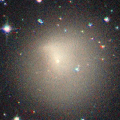
|
Major outburst occcured on Nov. 3. Now it is 12.5 mag (Nov. 3, Jean-Francois Soulier). In the Northern Hemisphere, it stays observable in good condition. In the Southern Hemisphere, it will be getting higher gradually.
Date(TT) R.A. (2000) Decl. Delta r Elong. m1 Best Time(A, h)
Nov. 2 10 4.40 10 25.0 6.506 6.241 70 14.0 3:23 (243, 18)
Nov. 9 10 6.94 10 5.1 6.398 6.243 76 14.0 3:14 (240, 21)
|

|
Now it is 13.6 mag (Oct. 19, ATLAS South Africa). It will fade out rapidly after this. It will be unobservable in February in the Northern Hemisphere, or in December in the Southern Hemisphere.
Date(TT) R.A. (2000) Decl. Delta r Elong. m1 Best Time(A, h)
Nov. 2 17 59.11 -25 29.8 2.080 1.632 50 14.1 20:04 ( 77, 28)
Nov. 9 18 21.67 -24 54.1 2.127 1.642 48 14.2 20:13 ( 76, 25)
|

|
It is expected to brighten up to 13.5 mag, and it will be observable in good condition in winter. Now it is 15.9 mag (Oct. 19, ATLAS Chile). Fading gradually. In the Northern Hemisphere, it stays observable in good condition. In the Southern Hemisphere, it will be getting lower gradually after this, and it will be unobservable in January.
Date(TT) R.A. (2000) Decl. Delta r Elong. m1 Best Time(A, h)
Nov. 2 6 41.92 -17 2.8 1.104 1.719 110 14.6 3:23 (205, 71)
Nov. 9 6 31.12 -13 31.9 0.993 1.709 119 14.3 3:14 (183, 69)
|

|
Now it is 14.1 mag (Aug. 29, Chris Wyatt). It stays 14 mag for a while. Now it is not observable. It will appear soon in the Northern Hemisphere, or in December in the Southern Hemisphere.
Date(TT) R.A. (2000) Decl. Delta r Elong. m1 Best Time(A, h)
Nov. 2 14 3.28 -19 9.7 5.981 5.000 7 14.4 3:23 (303,-10)
Nov. 9 14 10.55 -19 13.5 5.972 5.004 11 14.4 3:14 (301, -8)
|
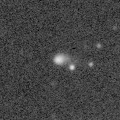
|
Now it is 14.3 mag (Oct. 27, W. Pei). It stays 14 mag for a while. It stays observable in good condition.
Date(TT) R.A. (2000) Decl. Delta r Elong. m1 Best Time(A, h)
Nov. 2 6 46.90 2 55.3 5.441 5.936 115 14.5 3:23 (195, 51)
Nov. 9 6 46.65 2 57.5 5.332 5.917 122 14.4 3:14 (188, 52)
|

|
It is expected to brighten up to 13 mag in 2025 autumn, and it will be observable in good condition. Now it is 14.4 mag (Oct. 17, Ken-ichi Kadota). It stays 15 mag for a while. In the Northern Hemisphere, it stays observable in good condition. In the Southern Hemisphere, it will be getting lower gradually after this, and it will be unobservable in February.
Date(TT) R.A. (2000) Decl. Delta r Elong. m1 Best Time(A, h)
Nov. 2 22 35.77 -5 28.0 3.933 4.494 118 14.5 20:04 (172, 60)
Nov. 9 22 36.61 -5 22.0 3.998 4.464 111 14.5 20:13 (155, 58)
|

|
First return of a new periodic comet which brightened up to 16 mag in 2012. Now it is 14.2 mag (Oct. 23, W. Pei). It will fade out rapidly after this. It will be fainter than 18 mag in February. In the Northern Hemisphere, it stays observable in good condition. In the Southern Hemisphere, it will be unobservable in December.
Date(TT) R.A. (2000) Decl. Delta r Elong. m1 Best Time(A, h)
Nov. 2 4 34.60 31 20.2 0.906 1.819 146 14.5 1:50 (180, 24)
Nov. 9 4 24.12 36 0.3 0.888 1.826 152 14.5 1:12 (180, 19)
|

|
It brightened up to 9.6 mag from February to March (Feb. 25, Thomas Lehmann). Now it is 14.2 mag (Oct. 22, Thomas Lehmann). Fading slowly. In the Northern Hemisphere, it stays observable in good condition. In the Southern Hemisphere, it will be unobservable soon.
Date(TT) R.A. (2000) Decl. Delta r Elong. m1 Best Time(A, h)
Nov. 2 20 6.00 38 35.3 3.413 3.632 94 14.6 20:04 (149, 7)
Nov. 9 20 14.12 37 14.4 3.535 3.703 91 14.7 20:13 (143, 5)
|
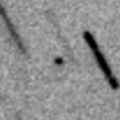
|
It will fade out rapidly after this. It will be fainter than 18 mag in February. In the Northern Hemisphere, it will be unobservable in December. But it will be observable again in January. In the Southern Hemisphere, it will never be observable after this.
Date(TT) R.A. (2000) Decl. Delta r Elong. m1 Best Time(A, h)
Nov. 2 15 50.69 -2 31.9 2.512 1.650 23 14.7 20:04 ( 79,-11)
Nov. 9 16 10.67 -2 47.3 2.609 1.739 22 15.0 20:13 ( 76,-14)
|

|
Now it is 16.2 mag (Oct. 26, Thomas Lehmann). It stays 15 mag for a while. In the Northern Hemisphere, it stays observable in good condition. In the Southern Hemisphere, it is not observable now.
Date(TT) R.A. (2000) Decl. Delta r Elong. m1 Best Time(A, h)
Nov. 2 7 37.17 67 36.4 2.103 2.595 108 15.3 3:23 (189,-14)
Nov. 9 7 53.76 69 1.6 2.056 2.587 111 15.2 3:14 (188,-15)
|
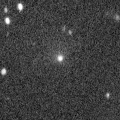
|
Very large comet. It is expected to brighten up to 13 mag in 2031. Now it is 15.2 mag (Sept. 26, Martin Masek). It stays 15 mag for a while. In the Northern Hemisphere, it is not observable now. In the Southern Hemisphere, it stays observable in good condition. In the Northern Hemisphere, it is not observable until 2030.
Date(TT) R.A. (2000) Decl. Delta r Elong. m1 Best Time(A, h)
Nov. 2 4 9.59 -70 14.2 15.704 15.792 93 15.5 1:23 ( 0, 55)
Nov. 9 4 5.99 -70 28.1 15.704 15.768 91 15.5 0:52 ( 0, 55)
|
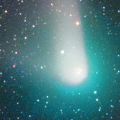
|
It brightened up to 8 mag from 2022 summer to 2023 spring. Now it is 14.7 mag (Oct. 27, Thomas Lehmann). It stays 16 mag for a while. It stays observable in good condition.
Date(TT) R.A. (2000) Decl. Delta r Elong. m1 Best Time(A, h)
Nov. 2 6 19.33 19 4.7 6.553 7.169 125 15.5 3:23 (183, 36)
Nov. 9 6 16.29 19 19.4 6.515 7.224 132 15.5 3:04 (180, 36)
|
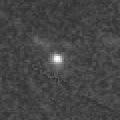
|
Now it is 15.8 mag (Oct. 28, Purple Mountain Observatory, XuYi Station). Brightening slowly. In the Northern Hemisphere, it stays observable in good condition.
Date(TT) R.A. (2000) Decl. Delta r Elong. m1 Best Time(A, h)
Nov. 2 8 54.02 22 29.1 2.517 2.706 90 15.7 3:23 (221, 20)
Nov. 9 9 0.86 21 55.8 2.417 2.696 95 15.5 3:14 (219, 22)
|

|
It was observed at 9-10 mag for a long time in 2023. Now it is 15.4 mag (Oct. 18, ATLAS South Africa). Fading slowly. In the Northern Hemisphere, it will never be observable after this. In the Southern Hemisphere, it will be getting lower gradually. But it will be getting higher again after February.
Date(TT) R.A. (2000) Decl. Delta r Elong. m1 Best Time(A, h)
Nov. 2 20 56.24 -67 0.7 6.007 5.900 79 15.6 20:04 ( 19, 54)
Nov. 9 20 53.78 -66 14.4 6.147 5.955 74 15.7 20:13 ( 24, 52)
|

|
Now it is 15.6 mag (Oct. 25, ATLAS-HKO, Haleakala). It stays 16 mag for a while. It stays observable in good condition.
Date(TT) R.A. (2000) Decl. Delta r Elong. m1 Best Time(A, h)
Nov. 2 6 41.62 11 44.6 2.888 3.476 118 15.7 3:23 (191, 43)
Nov. 9 6 42.08 11 15.8 2.819 3.487 125 15.7 3:14 (185, 44)
|

|
Now it is 16.5 mag (Oct. 19, ATLAS Chile). It stays 16 mag for a while. It stays extremely low in the Northern Hemisphere. But it will become high in autumn. In the Southern Hemisphere, it stays observable in good condition.
Date(TT) R.A. (2000) Decl. Delta r Elong. m1 Best Time(A, h)
Nov. 2 9 46.39 -35 1.6 3.891 3.602 65 15.7 3:23 (287, 46)
Nov. 9 9 41.51 -36 23.9 3.842 3.648 71 15.7 3:14 (287, 51)
|
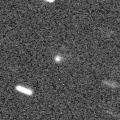
|
Now it is 16.5 mag (Apr. 3, Taras Prystavski). It stays 16 mag for a while. In the Northern Hemisphere, it will be getting higher gradually. In the Southern Hemisphere, it is not observable now, but it will be observable soon.
Date(TT) R.A. (2000) Decl. Delta r Elong. m1 Best Time(A, h)
Nov. 2 12 12.32 3 19.8 2.618 1.941 38 15.8 3:23 (268, -3)
Nov. 9 12 27.45 2 1.6 2.594 1.965 41 15.9 3:14 (268, -1)
|

|
Now it is 16.6 mag (Oct. 31, ATLAS Chile). It stays 16 mag for a while. It locates somewhat low in the Northern Hemisphere. But it will become high in winter. In the Southern Hemisphere, it stays observable in good condition.
Date(TT) R.A. (2000) Decl. Delta r Elong. m1 Best Time(A, h)
Nov. 2 8 16.48 -26 49.3 4.284 4.333 86 16.0 3:23 (262, 62)
Nov. 9 8 15.26 -26 54.7 4.167 4.306 91 15.9 3:14 (258, 66)
|

|
Now it is 15.7 mag (Oct. 15, ATLAS-MLO, Mauna Loa). It will fade out rapidly after this. It will be fainter than 18 mag in January. It stays observable in good condition.
Date(TT) R.A. (2000) Decl. Delta r Elong. m1 Best Time(A, h)
Nov. 2 2 7.54 6 41.1 1.459 2.443 170 16.1 23:18 (180, 48)
Nov. 9 2 1.70 6 34.7 1.512 2.476 163 16.3 22:45 (180, 48)
|
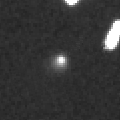
|
Now it is 16.6 mag (Oct. 26, ATLAS Chile). It stays 16 mag for a while. It locates somewhat low in the Northern Hemisphere. But it will become high in autumn. In the Southern Hemisphere, it stays observable in good condition.
Date(TT) R.A. (2000) Decl. Delta r Elong. m1 Best Time(A, h)
Nov. 2 7 10.38 -29 20.6 6.633 6.862 99 16.2 3:23 (251, 76)
Nov. 9 7 10.33 -29 45.1 6.553 6.848 103 16.1 3:14 (243, 80)
|

|
It will be observable at 15 mag for a long time in 2025 in the Northern Hemisphere. Now it is 17.0 mag (Oct. 30, ATLAS-HKO, Haleakala). Brightening slowly. In the Northern Hemisphere, it stays observable in good condition. In the Southern Hemisphere, it is not observable now, but it will appear in December.
Date(TT) R.A. (2000) Decl. Delta r Elong. m1 Best Time(A, h)
Nov. 2 11 48.03 25 49.4 5.219 4.743 56 16.2 3:23 (246,-10)
Nov. 9 11 53.35 26 38.9 5.098 4.720 62 16.1 3:14 (243, -8)
|

|
It brightened up to 8.3 mag in 2021-2022 winter (Jan. 6, 2022, Toshiyuki Takahashi). Now it is 15.1 mag (Aug. 2, Thomas Lehmann). It stays 17 mag for a while. In the Northern Hemisphere, it will never be observable after this. In the Southern Hemisphere, it will be getting higher gradually.
Date(TT) R.A. (2000) Decl. Delta r Elong. m1 Best Time(A, h)
Nov. 2 12 12.85 -50 29.9 9.664 8.992 45 16.4 3:23 (315, 26)
Nov. 9 12 17.13 -51 6.0 9.686 9.036 46 16.4 3:14 (315, 28)
|

|
Now it is 16.0 mag (Oct. 25, ATLAS-MLO, Mauna Loa). It stays 16 mag for a while. It stays observable in good condition.
Date(TT) R.A. (2000) Decl. Delta r Elong. m1 Best Time(A, h)
Nov. 2 1 59.10 19 2.5 2.108 3.093 171 16.5 23:10 (180, 36)
Nov. 9 1 54.35 18 17.1 2.099 3.066 164 16.4 22:38 (180, 37)
|

|
Now it is 16.8 mag (Oct. 26, Thomas Lehmann). It stays 17 mag for a while. It stays observable in good condition.
Date(TT) R.A. (2000) Decl. Delta r Elong. m1 Best Time(A, h)
Nov. 2 22 16.14 8 6.2 0.667 1.430 117 16.5 20:04 (168, 46)
Nov. 9 22 33.31 7 23.3 0.683 1.422 115 16.4 20:13 (160, 46)
|

|
Now it is 16.8 mag (May 18, ATLAS South Africa). It stays 16 mag for a while. It locates somewhat low in the Northern Hemisphere. In the Southern Hemisphere, it will be getting higher gradually.
Date(TT) R.A. (2000) Decl. Delta r Elong. m1 Best Time(A, h)
Nov. 2 11 37.15 -21 20.2 4.316 3.630 41 16.5 3:23 (284, 18)
Nov. 9 11 46.39 -22 28.7 4.248 3.618 45 16.4 3:14 (284, 21)
|

|
It stays 17 mag for a while. In the Northern Hemisphere, it will be getting higher gradually. In the Southern Hemisphere, it is not observable now, but it will appear in December.
Date(TT) R.A. (2000) Decl. Delta r Elong. m1 Best Time(A, h)
Nov. 2 12 45.71 1 55.4 3.435 2.630 30 16.6 3:23 (274, -9)
Nov. 9 12 56.36 0 46.3 3.421 2.665 34 16.6 3:14 (274, -6)
|

|
Now it is 15.5 mag (Oct. 25, ATLAS Chile). It stays 17 mag for a while. It stays extremely low in the Northern Hemisphere. In the Southern Hemisphere, it stays observable in good condition.
Date(TT) R.A. (2000) Decl. Delta r Elong. m1 Best Time(A, h)
Nov. 2 7 41.86 -46 15.8 6.116 6.150 87 16.6 3:23 (310, 69)
Nov. 9 7 36.38 -47 19.6 6.104 6.194 90 16.6 3:14 (319, 72)
|

|
Now it is 17.2 mag (Oct. 22, Hidetaka Sato). Brightening slowly. It will be unobservable in December. It will brighten up to 14.5 mag in 2025 spring. But the condition is bad.
Date(TT) R.A. (2000) Decl. Delta r Elong. m1 Best Time(A, h)
Nov. 2 17 28.15 -21 36.2 2.836 2.215 42 16.8 20:04 ( 77, 20)
Nov. 9 17 43.03 -22 10.1 2.867 2.193 39 16.6 20:13 ( 73, 16)
|
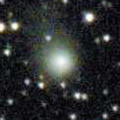
|
It brightened up to 12.1 mag in 2023 spring (May 20, 2023, Jose Guilherme de S. Aguiar). Now it is 16.8 mag (Oct. 4, ATLAS South Africa). It stays 17 mag for a while. It stays extremely low in the Northern Hemisphere. In the Southern Hemisphere, it stays observable in good condition.
Date(TT) R.A. (2000) Decl. Delta r Elong. m1 Best Time(A, h)
Nov. 2 6 52.39 -40 49.1 5.599 5.816 97 16.6 3:23 (307, 80)
Nov. 9 6 48.32 -41 10.3 5.592 5.864 101 16.7 3:14 (328, 83)
|

|
Now it is 18.9 mag (Sept. 30, Yasukazu Ikari). It stays 17 mag for a while. It stays observable in good condition.
Date(TT) R.A. (2000) Decl. Delta r Elong. m1 Best Time(A, h)
Nov. 2 8 9.79 7 25.9 4.672 4.886 96 16.7 3:23 (220, 39)
Nov. 9 8 11.09 6 33.2 4.578 4.894 102 16.6 3:14 (216, 42)
|

|
First return of a new periodic comet which brightened up to 15 mag in 2010. It is expected to brighten up to 15 mag from winter to spring, and it will be observable in excellent condition in the Northern Hemisphere. But actually, it is fainter than this ephemeris. Now it is 18.1 mag (Oct. 22, Purple Mountain Observatory, XuYi Station). Brightening slowly. It stays observable in good condition.
Date(TT) R.A. (2000) Decl. Delta r Elong. m1 Best Time(A, h)
Nov. 2 2 50.19 5 3.2 1.178 2.160 169 16.9 0:06 (180, 50)
Nov. 9 2 43.27 5 30.8 1.134 2.113 168 16.7 23:26 (180, 49)
|

|
Now it is 16.7 mag (Oct. 30, Hirohisa Sato). It stays 17 mag for a while. It will be getting lower gradually after this, and it will be unobservable in February in the Northern Hemisphere, or in December in the Southern Hemisphere.
Date(TT) R.A. (2000) Decl. Delta r Elong. m1 Best Time(A, h)
Nov. 2 22 28.21 24 53.4 5.193 5.791 122 16.7 20:04 (174, 30)
Nov. 9 22 23.44 23 51.5 5.243 5.747 116 16.7 20:13 (163, 29)
|

|
It brightened up to 12.0 mag in June (June 13, Ken-ichi Kadota). Now it is 15.3 mag (Oct. 27, Thomas Lehmann). Fading slowly. It will be fainter than 18 mag in February. In the Northern Hemisphere, it stays observable in good condition. It locates somewhat low in the Southern Hemisphere.
Date(TT) R.A. (2000) Decl. Delta r Elong. m1 Best Time(A, h)
Nov. 2 9 25.77 32 22.9 2.002 2.177 86 16.7 3:23 (220, 8)
Nov. 9 9 33.10 32 6.1 1.967 2.226 91 16.8 3:14 (219, 10)
|
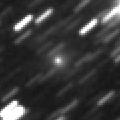
|
Very far object. Now it is 16.9 mag (Oct. 21, ATLAS Chile). It stays 17 mag for a while. In the Northern Hemisphere, it is not observable now. In the Southern Hemisphere, it stays observable in good condition.
Date(TT) R.A. (2000) Decl. Delta r Elong. m1 Best Time(A, h)
Nov. 2 1 30.10 -69 5.0 10.341 10.484 95 16.8 22:40 ( 0, 56)
Nov. 9 1 21.67 -68 40.2 10.396 10.491 92 16.8 22:05 ( 0, 56)
|

|
Now it is 16.3 mag (Oct. 20, ATLAS Chile). Fading gradually. It will be fainter than 18 mag in December. It stays observable in good condition.
Date(TT) R.A. (2000) Decl. Delta r Elong. m1 Best Time(A, h)
Nov. 2 0 37.94 -3 56.1 1.125 2.029 146 16.9 21:50 (180, 59)
Nov. 9 0 37.82 -3 53.3 1.172 2.032 139 17.0 21:22 (180, 59)
|

|
Parent asteroid of Geminids meteor shower. Now it is 18.5 mag (Sept. 12, ATLAS-HKO, Haleakala). It stays 17 mag for a while. In the Northern Hemisphere, it stays observable in good condition. It locates somewhat low in the Southern Hemisphere.
Date(TT) R.A. (2000) Decl. Delta r Elong. m1 Best Time(A, h)
Nov. 2 4 58.70 39 27.3 1.227 2.081 139 17.3 2:15 (180, 16)
Nov. 9 4 42.01 39 36.2 1.131 2.039 147 16.9 1:31 (180, 15)
|

|
Now it is 17.5 mag (Sept. 23, A. Diepvens). Fading slowly. It will be fainter than 18 mag in February. In the Northern Hemisphere, it stays observable in good condition. In the Southern Hemisphere, it will be getting lower gradually.
Date(TT) R.A. (2000) Decl. Delta r Elong. m1 Best Time(A, h)
Nov. 2 22 42.84 -6 27.7 1.387 2.070 120 17.0 20:04 (175, 61)
Nov. 9 22 47.76 -5 53.7 1.441 2.058 114 17.1 20:13 (160, 59)
|

|
It brightened up to 14.4 mag in summer (Aug. 17, Hiroshi Abe). Now it is 16.9 mag (Oct. 27, Thomas Lehmann). It will fade out rapidly after this. It will be fainter than 18 mag in December. In the Northern Hemisphere, it stays observable in good condition. It locates somewhat low in the Southern Hemisphere.
Date(TT) R.A. (2000) Decl. Delta r Elong. m1 Best Time(A, h)
Nov. 2 6 23.96 33 31.1 0.973 1.736 124 17.0 3:23 (184, 21)
Nov. 9 6 22.41 36 17.3 0.966 1.779 130 17.2 3:10 (180, 19)
|

|
Now it is 17.3 mag (Oct. 28, ATLAS Chile). It stays 17 mag for a while. It stays observable in good condition.
Date(TT) R.A. (2000) Decl. Delta r Elong. m1 Best Time(A, h)
Nov. 2 4 15.53 -14 10.2 3.159 3.979 140 17.2 1:31 (180, 69)
Nov. 9 4 12.28 -15 1.0 3.140 3.977 143 17.1 1:00 (180, 70)
|

|
It will brighten up to 14 mag in 2025 spring. Now it is 17.0 mag (Oct. 31, ATLAS Chile). Brightening gradually. It locates somewhat low in the Northern Hemisphere. In the Southern Hemisphere, it stays observable in good condition.
Date(TT) R.A. (2000) Decl. Delta r Elong. m1 Best Time(A, h)
Nov. 2 23 35.75 -30 41.3 1.524 2.178 118 17.2 20:47 (180, 86)
Nov. 9 23 34.45 -30 9.1 1.547 2.130 112 17.3 20:19 (180, 85)
|
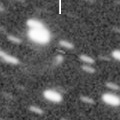
|
Now it is 17.4 mag (Oct. 20, ATLAS-MLO, Mauna Loa). It stays 18 mag for a while. In the Northern Hemisphere, it will be getting lower gradually. But it will be getting higher again after January. In the Southern Hemisphere, it will be unobservable soon. But it will be observable again in February.
Date(TT) R.A. (2000) Decl. Delta r Elong. m1 Best Time(A, h)
Nov. 2 19 5.21 22 59.6 4.702 4.587 77 17.2 20:04 (128, 11)
Nov. 9 19 5.88 21 30.5 4.820 4.611 71 17.3 20:13 (121, 6)
|

|
First return of a new periodic comet which brightened up to 15 mag in 2010. Now it is 17.4 mag (Oct. 13, Ken-ichi Kadota). It stays 18 mag for a while. In the Northern Hemisphere, it stays observable in good condition. It locates somewhat low in the Southern Hemisphere.
Date(TT) R.A. (2000) Decl. Delta r Elong. m1 Best Time(A, h)
Nov. 2 9 12.49 29 29.6 1.874 2.092 88 17.4 3:23 (220, 12)
Nov. 9 9 22.12 29 19.1 1.835 2.129 92 17.3 3:14 (218, 14)
|
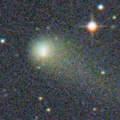
|
It brightened up to 11.1 mag in early 2022 (Mar. 31, 2022, F. Kugel, J.-G. Bosch, J. Nicolas). Now it is 16.9 mag (Oct. 20, ATLAS-MLO, Mauna Loa). It stays 18 mag for a while. In the Northern Hemisphere, it will be getting lower gradually. But it will be getting higher again after December. In the Southern Hemisphere, it will never be observable after this.
Date(TT) R.A. (2000) Decl. Delta r Elong. m1 Best Time(A, h)
Nov. 2 17 36.82 24 56.8 8.435 7.994 60 17.4 20:04 (117, -6)
Nov. 9 17 40.88 24 38.5 8.523 8.035 57 17.4 20:13 (112,-12)
|

|
Now it is 16.8 mag (Oct. 19, ATLAS South Africa). It stays 18 mag for a while. It will be unobservable in January.
Date(TT) R.A. (2000) Decl. Delta r Elong. m1 Best Time(A, h)
Nov. 2 19 30.59 -22 21.7 3.525 3.339 71 17.4 20:04 ( 92, 45)
Nov. 9 19 38.47 -22 10.5 3.612 3.333 65 17.5 20:13 ( 88, 39)
|
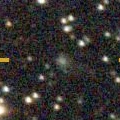
|
Now it is 17.6 mag (Oct. 13, Ken-ichi Kadota). It stays 18 mag for a while. In the Northern Hemisphere, it stays observable in good condition. It stays extremely low in the Southern Hemisphere.
Date(TT) R.A. (2000) Decl. Delta r Elong. m1 Best Time(A, h)
Nov. 2 7 42.26 40 2.1 6.598 6.974 108 17.5 3:23 (198, 12)
Nov. 9 7 43.02 40 16.5 6.514 6.987 114 17.5 3:14 (195, 13)
|

|
Peculiar asteroid moving along a cometary orbit. It stays 17 mag for a while. It stays observable in good condition.
Date(TT) R.A. (2000) Decl. Delta r Elong. m1 Best Time(A, h)
Nov. 2 3 58.08 -9 2.7 2.055 2.942 147 17.6 1:13 (180, 64)
Nov. 9 3 53.90 -10 33.5 1.996 2.892 149 17.5 0:42 (180, 65)
|

|
Now it is 17.5 mag (Oct. 2, ATLAS Chile). It stays 17 mag for a while. It will be unobservable in December. But it will be observable again in January in the Southern Hemisphere, or in February in the Northern Hemisphere. It is expected to brighten up to 13 mag in 2026, and it will be observable in excellent condition in the Northern Hemisphere. In the Southern Hemisphere, it locates very low at the high light.
Date(TT) R.A. (2000) Decl. Delta r Elong. m1 Best Time(A, h)
Nov. 2 18 29.64 -34 9.8 7.730 7.240 57 17.5 20:04 ( 71, 37)
Nov. 9 18 32.43 -33 39.9 7.781 7.197 50 17.5 20:13 ( 68, 30)
|

|
Now it is 17.5 mag (Oct. 22, ATLAS-HKO, Haleakala). Fading gradually. It will be fainter than 18 mag soon. In the Northern Hemisphere, it stays observable in good condition. It stays extremely low in the Southern Hemisphere.
Date(TT) R.A. (2000) Decl. Delta r Elong. m1 Best Time(A, h)
Nov. 2 2 6.90 38 6.2 1.439 2.380 156 17.6 23:18 (180, 17)
Nov. 9 1 57.89 38 36.0 1.461 2.395 154 17.7 22:41 (180, 16)
|

|
Peculiar asteroid moving along a cometary orbit. It will approach to Sun down to 0.49 a.u. on Nov. 29. Fading slowly. It will be fainter than 18 mag soon. It stays extremely low in the Northern Hemisphere. In the Southern Hemisphere, it will be unobservable in December.
Date(TT) R.A. (2000) Decl. Delta r Elong. m1 Best Time(A, h)
Nov. 2 11 2.63 -14 48.0 0.649 0.758 49 17.6 3:23 (273, 22)
Nov. 9 12 31.36 -33 23.1 0.501 0.660 36 18.2 3:14 (298, 18)
|

|
Now it is 17.8 mag (Oct. 25, Purple Mountain Observatory, XuYi Station). It stays 18 mag for a while. It stays observable in good condition.
Date(TT) R.A. (2000) Decl. Delta r Elong. m1 Best Time(A, h)
Nov. 2 3 20.31 16 28.8 3.544 4.518 167 17.7 0:36 (180, 38)
Nov. 9 3 15.66 16 18.3 3.542 4.530 175 17.7 0:04 (180, 39)
|

|
Now it is 17.8 mag (Oct. 20, Ken-ichi Kadota). It stays 18 mag for a while. In the Northern Hemisphere, it stays observable in good condition. It locates somewhat low in the Southern Hemisphere.
Date(TT) R.A. (2000) Decl. Delta r Elong. m1 Best Time(A, h)
Nov. 2 9 45.82 32 11.0 2.361 2.436 82 17.7 3:23 (224, 6)
Nov. 9 9 53.92 31 53.7 2.310 2.471 87 17.7 3:14 (222, 7)
|

|
Now it is 18.9 mag (Oct. 27, Mt. Lemmon Survey). It stays 18 mag for a while. In the Northern Hemisphere, it stays observable in good condition. It locates somewhat low in the Southern Hemisphere.
Date(TT) R.A. (2000) Decl. Delta r Elong. m1 Best Time(A, h)
Nov. 2 7 15.46 31 3.4 1.659 2.244 113 17.9 3:23 (195, 22)
Nov. 9 7 21.33 32 33.6 1.590 2.243 118 17.8 3:14 (192, 21)
|
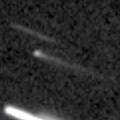
|
Now it is 16.4 mag (Oct. 25, ATLAS-MLO, Mauna Loa). It stays 18 mag for a while. It stays observable in good condition.
Date(TT) R.A. (2000) Decl. Delta r Elong. m1 Best Time(A, h)
Nov. 2 3 0.47 12 15.0 2.918 3.903 172 17.8 0:16 (180, 43)
Nov. 9 2 56.64 11 37.1 2.914 3.901 174 17.8 23:40 (180, 43)
|

|
Now it is 17.2 mag (Oct. 23, ATLAS Chile). It will fade out rapidly after this. It stays observable in good condition.
Date(TT) R.A. (2000) Decl. Delta r Elong. m1 Best Time(A, h)
Nov. 2 23 9.41 -16 57.3 2.055 2.708 121 17.9 20:21 (180, 72)
Nov. 9 23 10.76 -15 59.5 2.160 2.734 115 18.1 20:13 (167, 70)
|
|
![]()
 C/2022 E2 ( ATLAS )
C/2022 E2 ( ATLAS ) 12P/Pons-Brooks
12P/Pons-Brooks C/2023 C2 ( ATLAS )
C/2023 C2 ( ATLAS ) C/2024 G3 ( ATLAS )
C/2024 G3 ( ATLAS ) C/2024 B1 ( Lemmon )
C/2024 B1 ( Lemmon ) 29P/Schwassmann-Wachmann 1
29P/Schwassmann-Wachmann 1 37P/Forbes
37P/Forbes C/2024 M1 ( ATLAS )
C/2024 M1 ( ATLAS ) C/2021 G2 ( ATLAS )
C/2021 G2 ( ATLAS ) C/2022 QE78 ( ATLAS )
C/2022 QE78 ( ATLAS ) C/2022 N2 ( PanSTARRS )
C/2022 N2 ( PanSTARRS ) 487P/2024 N5 ( Siding Spring )
487P/2024 N5 ( Siding Spring ) C/2021 S3 ( PanSTARRS )
C/2021 S3 ( PanSTARRS ) C/2023 R2 ( PanSTARRS )
C/2023 R2 ( PanSTARRS ) C/2023 Q1 ( PanSTARRS )
C/2023 Q1 ( PanSTARRS ) C/2014 UN271 ( Bernardinelli-Bernstein )
C/2014 UN271 ( Bernardinelli-Bernstein ) C/2017 K2 ( PanSTARRS )
C/2017 K2 ( PanSTARRS ) P/2023 S1
P/2023 S1 C/2020 V2 ( ZTF )
C/2020 V2 ( ZTF ) 472P/2023 RL75 ( NEAT-LINEAR )
472P/2023 RL75 ( NEAT-LINEAR ) C/2022 L2 ( ATLAS )
C/2022 L2 ( ATLAS ) 30P/Reinmuth 1
30P/Reinmuth 1 C/2024 A1 ( ATLAS )
C/2024 A1 ( ATLAS ) 130P/McNaught-Hughes
130P/McNaught-Hughes C/2022 R6 ( PanSTARRS )
C/2022 R6 ( PanSTARRS ) C/2023 H5 ( Lemmon )
C/2023 H5 ( Lemmon ) C/2019 L3 ( ATLAS )
C/2019 L3 ( ATLAS ) 43P/Wolf-Harrington
43P/Wolf-Harrington 305P/Skiff
305P/Skiff C/2023 T3 ( Fuls )
C/2023 T3 ( Fuls ) 32P/Comas Sola
32P/Comas Sola C/2019 U5 ( PanSTARRS )
C/2019 U5 ( PanSTARRS ) 48P/Johnson
48P/Johnson C/2020 K1 ( PanSTARRS )
C/2020 K1 ( PanSTARRS ) C/2022 U3 ( Bok )
C/2022 U3 ( Bok ) P/2024 S3 ( Hill )
P/2024 S3 ( Hill ) C/2023 R1 ( PanSTARRS )
C/2023 R1 ( PanSTARRS ) 154P/Brewington
154P/Brewington C/2019 E3 ( ATLAS )
C/2019 E3 ( ATLAS ) 253P/PanSTARRS
253P/PanSTARRS (3200) Phaethon
(3200) Phaethon 190P/Mueller
190P/Mueller 146P/Shoemaker-LINEAR
146P/Shoemaker-LINEAR 242P/Spahr
242P/Spahr 49P/Arend-Rigaux
49P/Arend-Rigaux C/2022 U1 ( Leonard )
C/2022 U1 ( Leonard ) 492P/2024 O3 ( LINEAR )
492P/2024 O3 ( LINEAR ) C/2019 T4 ( ATLAS )
C/2019 T4 ( ATLAS ) 302P/Lemmon-PanSTARRS
302P/Lemmon-PanSTARRS C/2021 S4 ( Tsuchinshan )
C/2021 S4 ( Tsuchinshan ) (308607) 2005 WY3
(308607) 2005 WY3 C/2024 J3 ( ATLAS )
C/2024 J3 ( ATLAS ) 338P/McNaught
338P/McNaught (343158) Marsyas
(343158) Marsyas 117P/Helin-Roman-Alu 1
117P/Helin-Roman-Alu 1 50P/Arend
50P/Arend 33P/Daniel
33P/Daniel 276P/Vorobjov
276P/Vorobjov 89P/Russell 2
89P/Russell 2![]()


























































